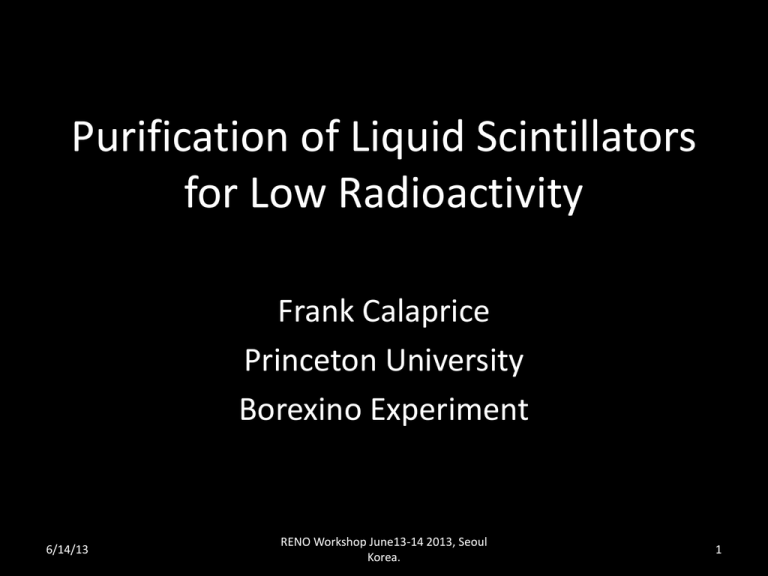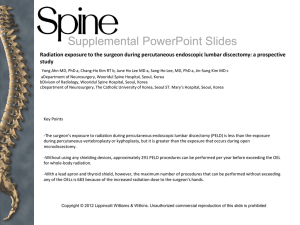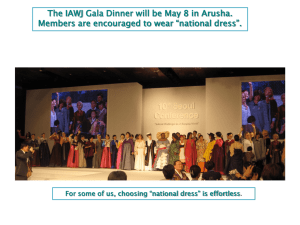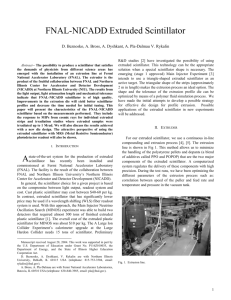Low Background in the Borexino Liquid Scintillator (20): F
advertisement

Purification of Liquid Scintillators for Low Radioactivity Frank Calaprice Princeton University Borexino Experiment 6/14/13 RENO Workshop June13-14 2013, Seoul Korea. 1 Liquid Scintillator Radioactivity • Extreme scintillator radio-purity is essential for solar neutrino measurements. • Initial Borexino data on 7Be, 8B, and pep solar neutrino data relied on process equipment developed in the 1990’s. – Distillation – Water extraction – Nitrogen stripping • Better accuracy on7Be, 8B, and pep solar neutrinos and possible measurement of pp and CNO neutrinos motivate a second phase of Borexino with lower backgrounds. – A new campaign of re-purification to achieve lower backgrounds for a second phase of Borexino started in 2010. 6/14/13 RENO Workshop June13-14 2013, Seoul Korea. 2 Requirements for Low Radioactivity Scintillator 1. Effective scintillator purification processes – Efficient removal of radioactive elements – Development of cleaning methods to remove radioactivity from equipment surfaces. – Purification of scintillator before and after filling detector. 2. Radio-pure containment vessel – Low bulk radioactivity – Low surface radioactivity 6/14/13 RENO Workshop June13-14 2013, Seoul Korea. 3 History • Thin nylon scintillator vessel and scintillator purification technologies were developed at Princeton University in the 1990’s. • 1990-1996 – Counting Test Facility (CTF) purification system • Demonstrated feasibility of low background scintillator • Reference: J.B. Benziger, et al, “A scintillator purification system for a large scale solar neutrino experiment”, NIM A 417, 278 (1998) • 1998-2002 – Full-scale purification system. • Reference: J. Benziger, et al , “A scintillator purification system for the Borexino solar neutrino detector” NIM A 587, 277 (2008). – Borexino Vessels developed. • Reference: J. Benziger, et al, “The nylon scintillator containment vessels for the Borexino solar neutrino experiment, NIM A 582, 509 (2007). 6/14/13 RENO Workshop June13-14 2013, Seoul Korea. 4 Borexino Vessel Filling Strategy • Vessels inflated with high purity synthetic air. • Vessels filled with de-ionized water. – Recent results suggest water may have been a mistake. • Scintillator distilled during filling. • Scintillator filled with scintillator from top, while draining water from bottom. 6/14/13 RENO Workshop June13-14 2013, Seoul Korea. 5 Scintillator Components • Tri-methyl benzene • PPO • DMP 6/14/13 RENO Workshop June13-14 2013, Seoul Korea. 6 Purification Procedure for Borexino Scintillator (PC+1.5 g/l PPO) • PPO wavelength shifter was purified by preparing a concentrated “master solution” of PPO dissolved in pseudocumene (PC). – The master solution was purified by a combination of water extraction followed by distillation. • PC was shipped to temporary storage vessels, then distilled and mixed with PPO master solution while filling the vessels. 6/14/13 RENO Workshop June13-14 2013, Seoul Korea. 7 Borexino Purification System Initial Filling detector 6/14/13 RENO Workshop June13-14 2013, Seoul Korea. 8 Scintillator Purification Plants • Distillation, water extraction, and nitrogen stripping of PC at 1 m3/hr • Distillation of concentrated PPO+PC in CTF purification plant at 20 liters/hr • Low-Argon-Krypton (LAK) N2 gas for stripping. • After fabrication all equipment was sent to special firm for “precision cleaning”. • After cleaning, th equipment was opened and assembled in a “radon-free” cleanroom. 6/14/13 RENO Workshop June13-14 2013, Seoul Korea. 9 6-tray distillation column and gas stripping column with packing. Assembly was done in Princeton radon-suppressed cleanroom. 6/14/13 RENO Workshop June13-14 2013, Seoul Korea. 10 Purification of PPO Wavelength Shifter 6/14/13 RENO Workshop June13-14 2013, Seoul Korea. 11 Borexino Energy Spectrum (BX3) Phys. Rev. Letts. 107 141302 (2011) 6/14/13 RENO Workshop June13-14 2013, Seoul Korea. 12 Nylon Scintillator Vessel • Low radioactivitiy scintillator required development of a low radioactivity nylon vessel container. • Low total radioactivity – Thin nylon file 120 micron thickness – Low bulk radioactivity [U], [Th] ~ 1 ppt • Careful selection of pellets • Special extrusion to reduce air contamination – Low surface radioactivity • Fabrication in special Class-100 clean room constructed at Princeton University to eliminate particulate (dust). • Hermeticlly sealed clean room with low radon air. • Sealed, shipped to Italy, then inflated with synthetic air in clean room air of Stainless Steel Sphere. 6/14/13 RENO Workshop June13-14 2013, Seoul Korea. 13 Borexino Re-Purification Systems Options for Water Extraction or Distillation followed by Nitrogen Stripping 6/14/13 RENO Workshop June13-14 2013, Seoul Korea. 14 Results of 6 cycles of Re-purification • 85Kr: 30 cpd/100t → < 5 cpd/100t • 210Bi: 70 cpd/100t → 20 cpd/100t • 210Po: Essentially unchanged (?) • 238U (226Ra): < 9.7 x 10-19 g/g – This is a spectacular result with < 1 ct/yr/100t of 214Bi-214Po delayed coincidences observed! • 232Th: 6/14/13 < 2.9 x 10-18 g/g RENO Workshop June13-14 2013, Seoul Korea. 15 General Comments 1. Nitrogen Stripping • Nitrogen stripping removed 85Kr very well. – The column was designed properly. – The upper limits of 39Ar and 85Kr in nitrogen was calculated in advance using standard chemical methods. – Methods to measure the argon and krypton in nitrogen were known. – Measurements were made to meet the requirements. 6/14/13 RENO Workshop June13-14 2013, Seoul Korea. 16 Low 39Ar and 85Kr (LAK) Nitrogen H. Simgen, G. Zuzel LRT 2006 • Measurement techniques: – Noble gas mass spectrometry. – Low background gas proportional counter • Borexino Requirements: – 85Kr: – 39Ar: < 0.2 mBqm3 < 0.6 mBq/m3 • Tested European Suppliers and delivery system. 6/14/13 RENO Workshop June13-14 2013, Seoul Korea. 17 General Comments 2. Water Extraction • • • • 238U reduced by factor >15 (214Bi-Po actually 226Ra) 232Th reduced by factor >3 (212Bi-Po) 210Pb reduced by factor of ~4 210Po not reduced. • The water extraction column was designed well, but… • The system to distill and re-use water had a flaw that required a change in procedure to drain wastes properly. The change was implemented for last 2 operations, which gave the best performance. • Studies of the water plant after the operations indicate high levels of 210Pb, and especially 210Po, in the water that contacts the scintillator. • The 210Pb and 210Po are produced by 222Rn in ground water. – De-ionization processes are not very effective for removing Pb and Po. – Distillation is needed, but may have to contend with volatile compounds of Po. 6/14/13 RENO Workshop June13-14 2013, Seoul Korea. 18 Summary of Scintillator Re-Purification 1. Successful Water Extraction & N2 Stripping • 85Kr, 238U (226Ra), 232Th, 210Pb reduced. 2. Failure to reduce 210Po significantly. 3. Discovery of radon daughters in de-ionized water at levels of 1-100 mBq/m3 • New processes and equipment are being developed for more efficient removal of Pb and Po from water. 4. A productive second phase of Borexino looks promising. 6/14/13 RENO Workshop June13-14 2013, Seoul Korea. 19 Conclusions 1. Initial filling of Borexino gave low background except for 210Po, which was very high. – Recent studies of the water show that de-ionzation processes are not effective for removing 210Po, and poor for removing 210Pb. – Thus, filling Borexino with water first may have caused the high level of 210Po. 2. Nitrogen stripping and water extraction are convenient for re-purification of multi-component scintillator, compared to distillation. – 85Kr removed well, and 210Pb, to some extent, 210Po, not well. 3. Removing the radon daughters from the water supply should help toward efficient removal of 210Pb and 210Po by water extraction. 6/14/13 RENO Workshop June13-14 2013, Seoul Korea. 20 Water Extraction System • Water is supplied by BX Water Plant (see M. Giammarchi talk). • Single stage evaporator (E201V201) produces steam that is condensed into V202. • Water from V202 flows into top of packed column C200 and returns to V201. • Scintillator enters bottom of C200, flows upwards against water and exists at top. • 10% of water is wasted out bottom of E201-V201 at same rate as make-up water is added. • Waste design is flawed. 6/14/13 RENO Workshop June13-14 2013, Seoul Korea. 21 Spares 6/14/13 RENO Workshop June13-14 2013, Seoul Korea. 22 Re-Purification of BX Scintillator 2010-2011 • From 2007 to 2010 the 210Bi background increased – Causes: Scintillator refill operations to cope with vessel leak. Other? – 210Bi rate: 15 → 70 cpd/100t – 85Kr rate: 30 cpd/100t (constant) • To reduce background, scintillator was re-purified using two processes: – Water extraction to remove 210Pb (210Bi) – Nitrogen stripping to remove 85Kr and other volatiles. • Distillation was deferred to develop a new distillation system for PPO. • Six purification operations were done, each of ~1 month duration. – Each operation processed all the scintillator in the detector once (320 m3). – Data were acquired to evaluate backgrounds after each operation. – Not all six operations were successful. 6/14/13 RENO Workshop June13-14 2013, Seoul Korea. 23 Energy Spectrum after Re-Purification 6/14/13 RENO Workshop June13-14 2013, Seoul Korea. 24









